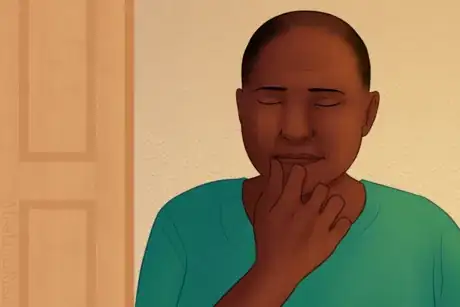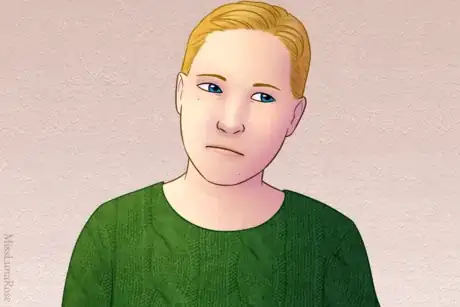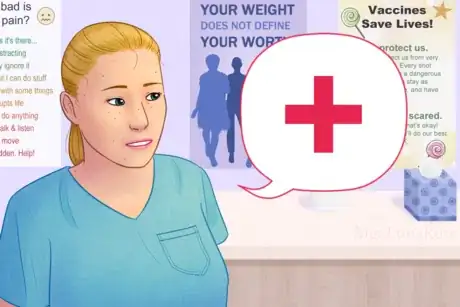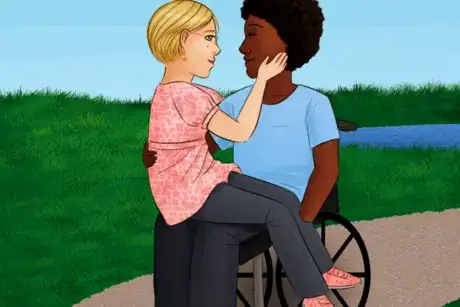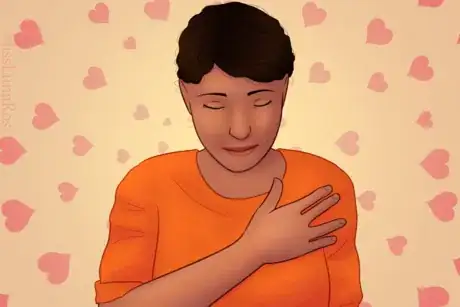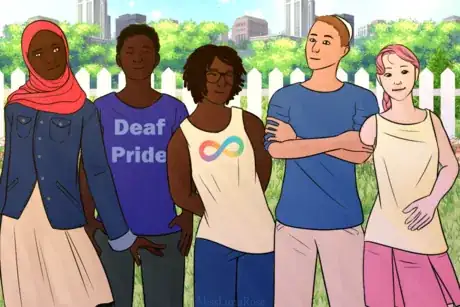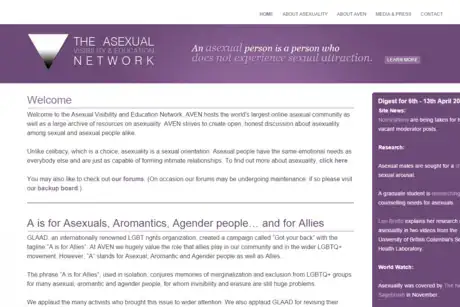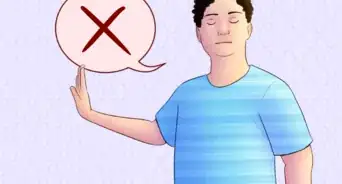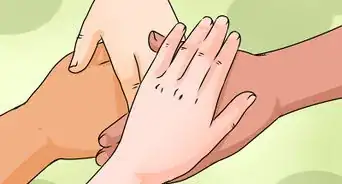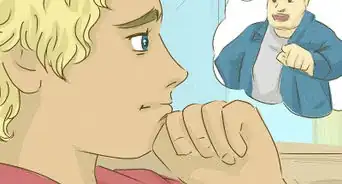This article was co-authored by Deb Schneider, LCSW, PPSC and by wikiHow staff writer, Danielle Blinka, MA, MPA. Deb Schneider is a Licensed Clinical Social Worker in private practice in Oakland, CA, and a Program Manager for the Weiland Health Initiative at Stanford University. With over 15 years of experience, she specializes in creating safe spaces, respectful of marginalized identities, at the high school and college levels. Deb holds a Bachelor’s degree in Sociology and Women's Studies from Clark University and a Master of Social Work (MSW) with Health Concentration from the University of California, Berkeley School of Social Welfare.
There are 8 references cited in this article, which can be found at the bottom of the page.
wikiHow marks an article as reader-approved once it receives enough positive feedback. In this case, 86% of readers who voted found the article helpful, earning it our reader-approved status.
This article has been viewed 256,653 times.
It’s healthy to have questions about your sexuality, and it might take you awhile to recognize your sexual identity. If you’re not sexually attracted to others or interested in sex, you may wonder if you’re asexual. Being asexual is a normal sexual identity, and it doesn’t necessarily mean that you don’t have a sex drive. While it’s important to remember that every asexual person is different, there are some commonalities that will help you recognize it in yourself.
Steps
Examining Your Feelings about Sex
-
1Notice if you don’t think about sex very often. Think about how often you think about sex, and for how long you think about sex. As an asexual, you might find that sex doesn’t really interest you. You might go days, weeks, or even years without thinking about sex.[1]
- For example, you might not be able to remember the last time you had a sexual thought. Similarly, you may realize that you occasionally think about sex when people bring it up, but it quickly leaves your mind.
- You can be an asexual, even if you think about sex a lot. Similarly, asexual people may also be "dirty-minded", even if they don't experience sexual attraction.
-
2Pay attention to how you feel when others make sexual comments. It’s common for people to talk about sex on TV, and you probably have friends who talk about sex. Think about how you feel when these topics come up. If you’re asexual, you might notice the following:[2]
- You get bored when people talk about their crush, their sexual desire, or their sexual experiences.
- Your mind wanders when people talk about sex.
- You don’t understand what makes someone “hot.”
- You pretend to be interested in sex to fit in.
-
3Think about how you react to sexually suggestive material. This includes things like sexy pictures, sex scenes in movies, and porn. Consider if you lack the desire to look at these materials. Then, think about how you react when you see them. You may be asexual if you don’t find these items stimulating and don’t understand why people do.[3]
- For instance, you might not understand why people like porn. You may find it boring or gross instead of arousing.
- You may feel bored or uncomfortable during sex scenes in movies.
- You may not get aroused when you see someone in revealing clothing.
-
4Reflect on whether or not you enjoyed any prior sexual encounters. You can still be asexual even if you’ve had sex before. In this case, think about how you felt about your sexual experience, why you did it, and if you’d do it again. For instance, you might still be asexual if any of the following apply:[4]
- You may have felt like you were supposed to have sex or that you’d like it if you tried it.
- You’ve never wanted to initiate sex.
- You may have had sex and realized you didn’t enjoy it.
- Sex might feel weird to you instead of fun.
- You may have felt like you were just going through the motions.
- You might find most other activities to be more fun than sex.
-
5Decide if you’d rather masturbate than have sex. You can be asexual and enjoy masturbation. You might get sexually aroused but not be attracted to other people. It’s normal to feel this way. If you enjoy masturbation but think you might be asexual, consider if you may just enjoy taking care of your own sexual needs.[5]
Tip: Masturbation can be a confusing topic when it comes to asexuality. You may still enjoy masturbating even though you’re asexual. On the other hand, you might not want to do it. You can feel either way and still be asexual.
-
6Talk to your doctor if you think you may have a medical issue impacting your interest or experience with sex. While asexuality is a normal, healthy sexual orientation, some mental and physical disorders can cause low libido or disinterest in sex. Visit your doctor if you’re concerned that your feelings toward sex are related to an underlying condition. Then, you can decide if you want to treat your condition. For instance, you might have 1 of the following:[6]
- Body dysmorphia is when you’re consumed by negative thoughts about your body or perceived flaws. Anyone can develop body dysmorphia, but it’s especially common with people who are transgender. If you have body dysmorphia, it may be hard for you to imagine or feel confident having sex with someone.
- Sexual dysfunction disorders cover a wide range of symptoms. Treatment is optional, depending on what the patient wants.
- Complex PTSD is a trauma response that can cause you to withdraw and be afraid to open up. You may have no desire for sexual relationships. With therapy, your sexual feelings may return.
Differentiating Between Types of Attraction
-
1Recognize the difference between romantic orientation and sexual orientation. Don’t assume that you can’t be romantic if you’re asexual. You can be asexual and still feel romantic attraction to someone. You may enjoy holding hands, cuddling, talking, sharing meals, and even kissing. Additionally, you can form a deep, lasting bond with someone.[7]
- You may also be aromantic, which means you don’t have romantic feelings. This means you may prefer to just enjoy friendships and familial relationships.
- It’s common for people who are asexual to be panromantic, which means you can fall in love with anyone regardless of gender. You may develop romantic feelings for someone of the same gender or of a different gender.
- Asexual individuals still express affection and care for other people, but they're not interested in expressing this in a sexual way.[8]
-
2Notice the difference between aesthetic, sensual, and sexual attraction. There are different types of attraction, and sometimes that can be confusing. Aesthetic attraction is when you think someone looks good but don’t necessarily feel sexually interested in them. Sensual attraction is when you want to cuddle, kiss, or be close to someone. Sexual attraction happens when you have the desire to have sexual contact with someone. Understand that you can have aesthetic and sensual attraction to someone and still be asexual.[9]
- If you’re aesthetically attracted to someone, you might think, “Her face is so beautiful.” However, you have no desire to be intimate.
- With sensual attraction, you might think, “This person is attractive and fun to be around. I want to cuddle and hold hands with them.”
- If it’s sexual attraction, you might find the person attractive and want to have sex with them.
Tip: It’s normal to have a sexual desire for someone and not act on it. This alone doesn’t mean you’re asexual.
-
3Watch for signs that you may be gray-asexual or demisexual. Both gray-asexuality and demisexuality are part of the asexual spectrum. You may be gray-asexual if you have some sexual interest or occasionally feel attracted to someone. Similarly, you might be demisexual if you feel sexual attraction to someone only after you’ve developed a deep emotional connection with them. If you’re conflicted about whether or not you may be asexual, consider if these labels might better reflect your sexual identity.[10]
- To figure out if you’re gray-asexual, think about times you’ve been attracted to someone or that you’ve gotten aroused by something sexual. This could be a sign of gray-asexuality.
- If you suspect you may be demisexual, consider if you’ve only been attracted to someone you love or deeply like. For instance, you might develop sexual feelings for someone you’ve dated for a long time but not be sexually attracted to anyone else.
Identifying as Asexual
-
1Accept that your asexual identity is totally normal. While people may not understand asexuality, it’s a normal sexual identity that is just part of who you are. Don’t worry about trying to change yourself. Instead, embrace your asexuality as apart of what makes you a unique, interesting person and be confident in who you are.[11]
- There’s nothing wrong or bad about being disinterested in sex.
- It’s okay to question your sexual identity and be uncertain about how you feel. Take as much time as you need to understand yourself.
- You’re not obligated to fulfill someone else’s stereotype or desires. You don’t need to have sex to prove something or make someone else happy.
-
2Recognize that every asexual person is unique. You may relate to some traits of asexuality but not others and still be considered asexual. Asexuality is a spectrum, so you may think differently about sex than others. Here are some examples:[12]
- You may be grossed out by sex, find it boring, or think it’s mildly enjoyable.
- You may want to never have sex or may like doing it because your partner enjoys it.
- You may not get sexually aroused at all, but it’s possible that you sometimes will.
- You may enjoy masturbating, you may use it as a release, or you might dislike masturbation.
-
3Join a support network if you want help understanding your identity. Learning more about asexuality can help you better understand yourself. Plus, it can empower you to share your identity with your friends, family, and romantic partners. Look for a support group online to connect with others who share your sexual identity.[13]
- For instance, join Asexuality Visibility & Education Network (AVEN).
-
4Take as much time as you need to decide your sexual identity. While some people instinctively know their sexual identity, it’s normal to go through a period of questioning and discovery. This can last as long as you need to figure out your preferences. Don’t rush to label your identity or feel pressured to explain yourself. Continue learning about yourself and how you feel, and you’ll figure out your sexual identity when you’re ready.[14]
- It’s okay to experiment with sexuality to find out if you like it, but don’t feel pressured to do it. Take your time and only do what feels comfortable to you.
Warnings
- If anyone threatens or hurts you because of your identification (which is wrong), report them to the authorities immediately. No one has the right to hurt or scare you.⧼thumbs_response⧽
- People may not understand your asexuality, and it may be frustrating to deal with their questions and comments. Don’t feel like you have to explain yourself or change for others.⧼thumbs_response⧽
- Coming out at work may cause you to experience prejudice. Sometimes people are cruel when they cannot relate. However, if you find yourself being treated unfairly because of your sexuality, you should report it to the human resources department.⧼thumbs_response⧽
References
- ↑ https://www.psychologytoday.com/us/blog/magnetic-partners/201406/asexuality
- ↑ http://www.asexualityarchive.com/possible-signs-of-asexuality-part-3/
- ↑ http://www.asexualityarchive.com/possible-signs-of-asexuality-part-1-about-you/
- ↑ http://www.asexualityarchive.com/possible-signs-of-asexuality-part-2-about-sex/
- ↑ https://www.psychologytoday.com/us/blog/magnetic-partners/201406/asexuality
- ↑ https://www.psychologytoday.com/us/blog/living-single/201609/asexuality-is-sexual-orientation-not-sexual-dysfunction
- ↑ https://www.psychologytoday.com/us/blog/magnetic-partners/201406/asexuality
- ↑ https://www.thetrevorproject.org/resources/article/understanding-asexuality/
- ↑ http://www.whatisasexuality.com/am-i-ace/teen/
About This Article
While every asexual person is different, there are some patterns that may help guide you as you figure out if you’re asexual. For example, you might not think about sex very much or even understand the appeal of it. Additionally, it may be hard for you to understand why some people are considered “hot” or why someone would want to have sex with another person. If you’ve had sexual experiences, consider if you felt let down, thought it was more weird than exciting, or would rather have been doing something else, all of which could indicate that you’re asexual. To learn how to tell the difference between sexual orientation and romantic orientation, keep reading!

